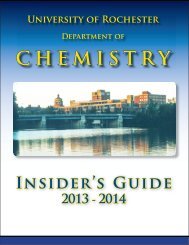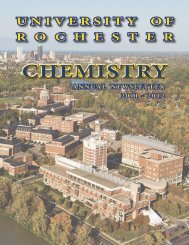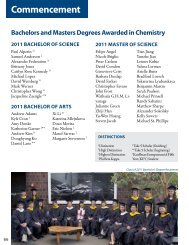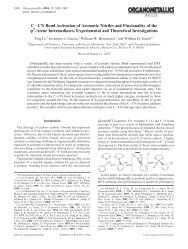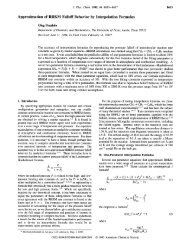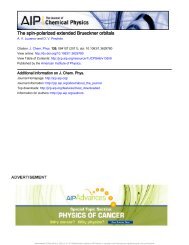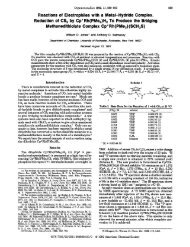Organometallics, 1999, 18, 1754-1760 - Chemistry - University of ...
Organometallics, 1999, 18, 1754-1760 - Chemistry - University of ...
Organometallics, 1999, 18, 1754-1760 - Chemistry - University of ...
You also want an ePaper? Increase the reach of your titles
YUMPU automatically turns print PDFs into web optimized ePapers that Google loves.
<strong>1754</strong> <strong>Organometallics</strong> <strong>1999</strong>, <strong>18</strong>, <strong>1754</strong>-<strong>1760</strong><br />
Photochemical C-H Activation and Ligand Exchange<br />
Reactions <strong>of</strong> CpRe(PPh 3 ) 2 H 2 . Phosphine Dissociation Is<br />
Not Involved<br />
William D. Jones,* Glen P. Rosini, and John A. Maguire<br />
Department <strong>of</strong> <strong>Chemistry</strong>, <strong>University</strong> <strong>of</strong> Rochester, Rochester, New York 14627<br />
Received December 4, 1998<br />
The dihydride CpRe(PPh 3 ) 2 H 2 (1) catalyzes H/D exchange between C 6 D 6 and other arenes<br />
or alkanes. Compound 1 also undergoes photochemical phosphine substitution with PMe 3<br />
to give CpRe(PPh 3 )(PMe 3 )H 2 and then CpRe(PMe 3 ) 2 H 2 . Mechanistic studies <strong>of</strong> these reactions<br />
are inconsistent with [CpRe(PPh 3 )H 2 ] as an intermediate. An alternative mechanism is<br />
presented proposing that the active species for H/D exchange is the 14-electron cyclic allyl<br />
intermediate [(η 3 -C 5 H 7 )Re(PPh 3 ) 2 ] (E), in which both hydrides have migrated from the<br />
rhenium to the cyclopentadienyl ligand. This intermediate accounts for the fact that (1)<br />
deuterium does not exchange into the hydride ligands <strong>of</strong> complex 1 during the H/D exchange<br />
catalysis and (2) phosphine substitution occurs by an associative pathway. The precursor to<br />
intermediate E,[(η 4 -C 5 H 6 )Re(PPh 3 ) 2 H] (D), can undergo reversible orthometalation, allowing<br />
H/D exchange between the hydride ligands and the ortho phosphine positions. Evidence is<br />
presented to support this new mechanism as well as to rule out other feasible mechanisms.<br />
Introduction<br />
The intermolecular activation and functionalization<br />
<strong>of</strong> C-H bonds in arenes and (more importantly) alkanes<br />
has been an area <strong>of</strong> extensive research for almost three<br />
decades now, since the discovery <strong>of</strong> cyclometalation in<br />
the early 1960s. 1 Since then, there have been many<br />
examples <strong>of</strong> transition-metal complexes capable <strong>of</strong><br />
activating C-H bonds, 2 and there have been several<br />
studies that ascertain the relative thermodynamic<br />
stabilities and strengths <strong>of</strong> various metal-carbon bonds<br />
for a given R-M-H series. 3 Two common pathways<br />
identified for C-H activation that are important to<br />
organometallic chemists are electrophilic metathesis<br />
and oxidative addition. 4<br />
In general, the complexes that have been shown to<br />
be capable <strong>of</strong> oxidatively adding C-H bonds contain<br />
electron-rich metal centers in low oxidation states. The<br />
ligands used in these systems are typically Cp (or Cp*),<br />
phosphines, and/or hydrides. One such complex that was<br />
found to be able to activate C-H bonds photochemically<br />
(1) (a) Kliman, J. P.; Dubeck, M. J. Am. Chem. Soc. 1963, 85, 1544-<br />
1545. (b) Horiie, S.; Murahashi, S. Nippon Kagaku Zasshi 1960, 33,<br />
247-251. (c) Ryabov, A. D. Chem. Rev. 1990, 90, 403-424.<br />
(2) (a) Crabtree, R. H. Chem. Rev. 1985, 85, 245-269. (b) Shilov, A.<br />
E. Activation <strong>of</strong> Saturated Hydrocarbons by Transition Metal Complexes;<br />
D. Reidel: Boston, 1984.<br />
(3) (a) Janowicz, A. H.; Bergman, R. G. J. Am. Chem. Soc. 1983,<br />
105, 3929-3939. (b) Buchanan, J. M.; Stryker, J. M.; Bergman, R. G.<br />
J. Am. Chem. Soc. 1986, 108, 1537-1550. (c) Wax, M. J.; Stryker, J.<br />
M.; Buchanan, M.; Kovac, C. A.; Bergman, R. G. J. Am. Chem. Soc.<br />
1984, 106, 1121-1122. (d) Jones, W. D.; Feher, F. J. J. Am. Chem.<br />
Soc. 1984, 106, 1650-1663. (e) Nolan, S. P.; H<strong>of</strong>f, C. D.; Stoutland, P.<br />
O.; Newman, L. J.; Buchanan, J. M.; Bergman, R. G.; Yang, G. K.;<br />
Peters, K. S. J. Am. Chem. Soc. 1987, 109, 3143-3145. (f) Halpern, J.<br />
Inorg. Chim. Acta 1985, 100, 41-48. (g) Jones, W. D.; Hessell, E. T. J.<br />
Am. Chem. Soc. 1993, 115, 554-562.<br />
(4) Hill, C. L. Activation and Functionalization <strong>of</strong> Alkanes; Wiley:<br />
New York, 1989.<br />
was CpRe(PPh 3 ) 2 H 2 (1). 5 Earlier studies showed that 1<br />
was capable <strong>of</strong> catalyzing H/D exchange between a<br />
deuterated solvent (typically benzene or THF) and a<br />
variety <strong>of</strong> arene and alkane substrates, including methane<br />
(eq 1). Turnover numbers exceeded 1000 for THF<br />
or diethyl ether in C 6 D 6 . The mechanism originally<br />
proposed for the catalytic H/D exchange is typical <strong>of</strong> that<br />
invoked for other H/D exchange systems, namely, the<br />
photochemical loss <strong>of</strong> PPh 3 to generate the 16-electron<br />
fragment [CpRe(PPh 3 )H 2 ], which was then active in H/D<br />
exchange (Scheme 1).<br />
There were several experiments conducted that helped<br />
support this mechanism. The H/D exchange was completely<br />
inhibited upon addition <strong>of</strong> small amounts <strong>of</strong><br />
triphenylphosphine. Also, irradiation <strong>of</strong> 1 in the presence<br />
<strong>of</strong> phosphines, CO, and CNR leads to the formation<br />
<strong>of</strong> substituted products <strong>of</strong> the type CpRe(PPh 3 )(L)H 2 and<br />
CpRe(L) 2 H 2 . 6 One observation which did not support the<br />
proposed mechanism was that the 1 H NMR resonance<br />
for the hydride ligands <strong>of</strong> 1 at δ -9.95 (t, J ) 40.1 Hz,<br />
2 H) always integrated as two protons, even after the<br />
hundreds or thousands <strong>of</strong> turnovers <strong>of</strong> H/D exchange.<br />
This observation is difficult to reconcile with the mechanism<br />
proposed in Scheme 1, as all known polyhydrides<br />
which catalyze H/D exchange among hydrocarbons via<br />
oxidative addition/reduction elimination incorporate<br />
(5) Jones, W. D.; Maguire, J. A. <strong>Organometallics</strong> 1986, 5, 590-591.<br />
(6) Jones, W. D.; Maguire, J. A.; Rosini, G. P. Inorg. Chim. Acta<br />
1998, 270, 77-86.<br />
10.1021/om9809872 CCC: $<strong>18</strong>.00 © <strong>1999</strong> American Chemical Society<br />
Publication on Web 04/06/<strong>1999</strong>
C-H Activation and Ligand Exchange <strong>of</strong> CpRe(PPh 3 ) 2 H 2 <strong>Organometallics</strong>, Vol. <strong>18</strong>, No. 9, <strong>1999</strong> 1755<br />
Scheme 1.<br />
“Simple” H/D Exchange Mechanism<br />
Figure 1. UV-vis spectrum <strong>of</strong> 1 in C 6 H 6 . The absorbances<br />
<strong>of</strong> the 365 nm band-pass and 345 nm long-pass filters used<br />
are also shown.<br />
deuterium into the hydride positions <strong>of</strong> the catalyst. The<br />
studies presented in this paper shed light on the<br />
photochemistry <strong>of</strong> 1, in terms <strong>of</strong> both the phosphine<br />
substitution and the H/D exchange reaction. A new<br />
mechanism is proposed that builds upon literature<br />
precedents involving migration <strong>of</strong> the hydride ligands<br />
to the Cp ring.<br />
Results<br />
Preparation and H/D Exchange Reactivity <strong>of</strong><br />
CpReH 2 (PPh 3 ) 2 (1). The reaction <strong>of</strong> ReH 7 (PPh 3 ) 2 with<br />
excess cyclopentadiene in THF yields the η 4 -cyclopentadiene<br />
complex (η 4 -C 4 H 6 )ReH 3 (PPh 3 ) 2 , which is easily<br />
converted to 1 by the thermal loss <strong>of</strong> H 2 at 60 °C. 7<br />
Thermolysis <strong>of</strong> samples <strong>of</strong> 1 at elevated temperatures<br />
(up to 220 °C) results in no reaction (either ligand<br />
exchange with phosphine or solvent activation), as<br />
evidenced by NMR spectroscopy. 6 As mentioned above,<br />
however, photolysis <strong>of</strong> samples <strong>of</strong> 1 (λ > 345 nm) shows<br />
evidence for both ligand exchange reactions (with a<br />
variety <strong>of</strong> σ-donor ligands) and reversible C-H activation<br />
reactions (by H/D exchange with deuterated solvents).<br />
The UV-vis spectrum <strong>of</strong> 1 in C 6 H 6 shows a welldefined<br />
absorption maximum at 328 nm (ɛ ) 1413 M -1<br />
cm -1 ; Figure 1). Table 1 shows several examples <strong>of</strong> the<br />
H/D exchange reactions catalyzed by 1. Figure 2 shows<br />
how the H/D exchange is initially linear but slows with<br />
continued irradiation due to the formation <strong>of</strong> small<br />
amounts <strong>of</strong> PPh 3 that are produced by the slow photodecomposition<br />
<strong>of</strong> 1. Free PPh 3 (∼1-2%) is observed in<br />
these samples as the photolysis proceeds. The H/D<br />
exchange can be completely inhibited by the addition<br />
<strong>of</strong> free PPh 3 to the initial solution.<br />
As indicated in Table 1, the primary C-H bonds <strong>of</strong><br />
propane are much more reactive than the secondary<br />
C-H bonds, yet the secondary bonds <strong>of</strong> cyclopentane<br />
are as reactive as the primary C-H bonds <strong>of</strong> propane<br />
(7) Jones, W. D.; Maguire, J. A. <strong>Organometallics</strong> 1987, 6, 1301-<br />
1311.<br />
Table 1. Photochemical H/D Exchange Reactions<br />
Catalyzed by CpRe(PPh 3 ) 2 H 2 in C 6 D 6<br />
a<br />
alkane [alkane], M<br />
irradiation time,<br />
min no. <strong>of</strong> turnovers<br />
methane ∼0.04 <strong>18</strong>0 68<br />
ethane 2 300 33<br />
propane 2 60 51, c 2.5 d<br />
120 72, c 4.0 d<br />
<strong>18</strong>0 77, c 4.0 d<br />
cyclopropane 5 40 250<br />
70 369<br />
120 409<br />
<strong>18</strong>0 423<br />
cyclopentane 1.2 30 42<br />
70 74<br />
120 87<br />
300 90<br />
THF b 6.2 60 488, e 840 f<br />
100 520, e 895 f<br />
a [CpRe(PPh 3) 2H 2] ) 1.2 mM. b [CpRe(PPh 3) 2H 2] ) 0.6 mM.<br />
c Primary exchange. d Secondary exchange. e β exchange. f R exchange.<br />
Figure 2. Photocatalyzed H/D exchange between n-<br />
pentane and C 6 D 6 by 1.<br />
in independent experiments. Figure 3 shows a plot <strong>of</strong><br />
the H/D exchange between propane and C 6 D 6 solvent<br />
as a function <strong>of</strong> alkane concentration. From the initial<br />
rates <strong>of</strong> exchange, the reaction appears to be first order<br />
in propane concentration.<br />
In addition, competition studies were performed using<br />
a mixture <strong>of</strong> alkanes in C 6 D 6 . Irradiation <strong>of</strong> 1 in the<br />
presence <strong>of</strong> a CH 4 /C 2 H 6 mixture (100 equiv each)<br />
revealed a 2:1 kinetic selectivity for H/D exchange into<br />
methane vs ethane on a per-molecule basis. Similarly,
1756 <strong>Organometallics</strong>, Vol. <strong>18</strong>, No. 9, <strong>1999</strong> Jones et al.<br />
Figure 3. Effect <strong>of</strong> propane concentration on H/D exchange<br />
with benzene-d 6 catalyzed by 1: (2) 3.84 M; (9)<br />
2.56 M; ([) 1.28 M.<br />
Figure 5. Dependence <strong>of</strong> k obsd on [PMe 3 ] for the photosubstitution<br />
<strong>of</strong> 1: (a) k obsd vs [PMe 3 ]; (b) 1/k obsd vs 1/[PMe 3 ].<br />
A kinetic scheme for the photochemical associative<br />
Figure 4. Effect <strong>of</strong> [PMe 3 ] on phosphine photosubstitution exchange <strong>of</strong> PPh 3 in 1 with PMe 3 is shown in eq 2. If<br />
rate: (b) 0.0053 M; (2) 0.027 M; (9) 0.109 M; ([) 0.574 M.<br />
Table 2. Effect <strong>of</strong> [PMe 3 ] on Rates <strong>of</strong> Phosphine<br />
Photosubstitution in 1<br />
sample [PMe 3], M k obsd, s -1<br />
1 0.0053 [4.3(9)] × 10 -6<br />
2 0.027 [1.12(13)] × 10 -5<br />
3 0.109 [1.56(11)] × 10 -5<br />
a competition between CH 4 and c-C 5 H 10 (100 equiv each)<br />
revealed a 1.6:1 preference for methane exchange over<br />
the secondary C-H bonds <strong>of</strong> cyclopentane. A competition<br />
between benzene and propane (100 equiv each) in<br />
THF-d 8 solvent as deuterium source produced an 8.2:1<br />
preference for benzene exchange over propane primary<br />
C-H exchange.<br />
Phosphine Exchange Study. Four samples <strong>of</strong> 1 in<br />
C 6 D 6 (5.1 × 10 -3 M) were prepared containing different<br />
excess amounts <strong>of</strong> PMe 3 , as shown in Table 2. The<br />
samples were then irradiated (λ >345 nm) using a<br />
merry-go-round apparatus. The phosphine exchange<br />
was followed by 1 H NMR spectroscopy by monitoring<br />
the ratio <strong>of</strong> the ortho phosphine protons <strong>of</strong> 1 with those<br />
<strong>of</strong> the monosubstituted product CpRe(PPh 3 )(PMe 3 )H 2 .<br />
Short irradiation times were used to avoid the formation<br />
<strong>of</strong> the disubstituted CpRe(PMe 3 ) 2 H 2 . Plots <strong>of</strong> ln([1]/[1] 0 )<br />
vs time are linear, with the slope varying with the<br />
concentration <strong>of</strong> PMe 3 (Figure 4, Table 2). 8<br />
(8) The solutions used in these studies were optically dense in the<br />
near-UV region,and the incident photon flux is constant. Consequently,<br />
one might expect a plot <strong>of</strong> the disappearance <strong>of</strong> 1 vs time to be linear<br />
rather than logarithmic, as seen in the first few turnovers <strong>of</strong> H/D<br />
exchange. The product CpRe(PPh 3)(PMe 3)H 2 has a UV spectrum very<br />
similar to that <strong>of</strong> 1, however, and consequently the inner filter effect<br />
gives rise to an exponential decay <strong>of</strong> 1. That is, as the reaction proceeds<br />
a smaller fraction <strong>of</strong> the light is being absorbed by 1, and hence its<br />
rate <strong>of</strong> decay slows.<br />
one assumes steady-state conditions on the intermediate<br />
D, then one can solve the kinetic expression for the<br />
disappearance <strong>of</strong> 1 and for k obs as shown in eqs 3 and 4.<br />
rate ) (rate <strong>of</strong> formation <strong>of</strong> D) ×<br />
(fraction <strong>of</strong> D that goes on to form 2)<br />
- d[1]<br />
dt<br />
[1] k 2 [PMe 3 ]<br />
) I 0 AΦ<br />
[1] A<br />
0 k -1 + k 2 [PMe 3 ] ) k [1]<br />
obsd (3)<br />
[1] 0<br />
k obsd ) k 1 k 2 [PMe 3 ]<br />
k -1 + k 2 [PMe 3 ]<br />
(4)<br />
In this analysis, I 0 is the incident light intensity, [1]/[1] 0<br />
is the fraction <strong>of</strong> light absorbed by 1, A is the area <strong>of</strong><br />
the sample being irradiated, and Φ A is the quantum<br />
yield for formation <strong>of</strong> D. Since all <strong>of</strong> these quantities<br />
except [1]/[1] 0 are constant for the series <strong>of</strong> irradiations,<br />
they are lumped together as the rate constant k 1 in eq<br />
4.<br />
This scheme predicts that k obsd should be dependent<br />
on the concentration <strong>of</strong> PMe 3 used and that the reaction<br />
should follow saturation kinetics. Figure 5a shows that<br />
this is indeed the case. Note that a direct associative<br />
attack by PMe 3 on the excited state <strong>of</strong> 1 would not be<br />
expected to show saturation behavior. From eq 4, a plot<br />
<strong>of</strong> 1/k obsd versus 1/[PMe 3 ] should be linear with a slope<br />
<strong>of</strong> k -1 /k 1 k 2 and an intercept <strong>of</strong> 1/k 1 . Figure 5b shows this<br />
plot, the intercept and slope <strong>of</strong> which give k 1 ) [1.9(3)]<br />
× 10 -5 s -1 and k -1 /k 2 ) [1.8(2)] × 10 -2 M. These data
C-H Activation and Ligand Exchange <strong>of</strong> CpRe(PPh 3 ) 2 H 2 <strong>Organometallics</strong>, Vol. <strong>18</strong>, No. 9, <strong>1999</strong> 1757<br />
Scheme 2<br />
Figure 6. Photochemical exchange <strong>of</strong> PPh 3 -d 15 into 1.<br />
support an associative mechanism for phosphine exchange<br />
with the photochemically formed intermediate<br />
D. An alternative explanation for saturation behavior,<br />
namely that the rate is being limited by the photon flux<br />
(i.e., Φ substitution ≈ 1), is unlikely in that this would<br />
require that the excited state be sufficiently long-lived<br />
to undergo bimolecular reaction with PMe 3 . This possibility<br />
can also be discounted, as these substitution<br />
reactions (qualitatively) have quantum yields that are<br />
substantially less than 1.<br />
Comparison <strong>of</strong> the Rates <strong>of</strong> H/D Exchange and<br />
Phosphine Exchange. Since both ligand exchange and<br />
H/D exchange occur via associative mechanisms, the<br />
relative rates <strong>of</strong> these two reactions can be compared if<br />
the substrate concentrations are known. Two NMR<br />
samples <strong>of</strong> 1 in C 6 D 6 (5.14 × 10 -3 M) were prepared.<br />
To the first sample was added excess PPh 3 -d 15 (0.224<br />
M), and to the second sample was added excess n-<br />
pentane (0.88 M). 9 The two samples were irradiated<br />
through a 345 nm filter, and a merry-go-round apparatus<br />
was used to ensure that both samples received<br />
the same number <strong>of</strong> photons. The phosphine exchange<br />
reaction was monitored by integrating the ortho resonances<br />
<strong>of</strong> bound and free PPh 3 -d 0 (by 1 H NMR spectroscopy).<br />
The appearance <strong>of</strong> free PPh 3 -d 0 is exponential<br />
(Figure 6), and fitting to eq 5 gives k obsd ) [1.60(8)] ×<br />
[PPh 3 -d 0 ] ) 2[1] 0 (1 - e -k obst ) (5)<br />
10 -5 s -1 . The H/D exchange catalysis was followed by<br />
monitoring the ratio <strong>of</strong> the internal standard c-C 6 D 12<br />
to n-pentane-d by 2 H NMR. The number <strong>of</strong> turnovers<br />
was then calculated as shown in eq 6. A plot <strong>of</strong> turnover<br />
no. <strong>of</strong> turnovers ) 12( area(C 5 H 11 D)<br />
area(c-C 6 D 12 ))( mol <strong>of</strong> c-C 6 D 12<br />
mol <strong>of</strong> Re )<br />
(6)<br />
number vs time is linear for ∼3 h (25 turnovers), after<br />
which time the catalyst decomposition begins to inhibit<br />
the reaction. From the slope <strong>of</strong> this line, k obsd ) [2.1(4)]<br />
× 10 -3 s -1 for H/D exchange. After correcting the<br />
observed first-order rates <strong>of</strong> H/D exchange and phosphine<br />
exchange for the substrate concentrations, we<br />
found that n-pentane-d is formed at a rate <strong>of</strong> ∼37 times<br />
faster than the rate at which phosphine exchange takes<br />
place.<br />
(9) Trimethylphosphine was not used for this study in order to<br />
eliminate any effects that changes in the UV-vis spectra <strong>of</strong> the<br />
substituted complexes (A and/or ɛ) might introduce into the kinetics<br />
<strong>of</strong> the reaction mechanism due to changes in the amount <strong>of</strong> light<br />
absorbed during the reaction. See: Drolet, D. P.; Lees, A. J. J. Am.<br />
Chem. Soc. 1992, 114, 4<strong>18</strong>6-4194.<br />
Reaction <strong>of</strong> CpReH 2 (PPh 3 ) 2 with D 2 . To test for<br />
the photodissociation <strong>of</strong> H 2 from 1, a sample <strong>of</strong> 1 in C 6 D 6<br />
(5.14 × 10 -3 M) was placed under an atmosphere <strong>of</strong> D 2<br />
and the sample irradiated through a 345 nm filter. If<br />
H 2 dissociation were occurring, then one would expect<br />
to see the rapid formation <strong>of</strong> CpReD 2 (PPh 3 ) 2 and free<br />
H 2 . The reaction was followed by 1 H NMR spectroscopy,<br />
which showed the slow formation <strong>of</strong> CpReD n H 4-n (PPh 3 ),<br />
where integration indicates n ) 2. The hydride resonance<br />
<strong>of</strong> 1 remains sharp throughout the reaction and<br />
does not show a decrease in intensity relative to the<br />
phosphine or Cp resonances which would be expected<br />
for the direct formation <strong>of</strong> CpReD 2 (PPh 3 ) 2 . It therefore<br />
seems reasonable that 1 does not lose H 2 upon photolysis.<br />
Preparation and Reactivity <strong>of</strong> CpReHD(PPh 3 ) 2<br />
(2). The reaction <strong>of</strong> ReD 7 (PPh 3 ) 2 with excess CpH at 60<br />
°C results in the formation <strong>of</strong> CpReHD(PPh 3 ) 2 , as shown<br />
in Scheme 2. 7 The 1 H NMR spectrum <strong>of</strong> 2 is essentially<br />
identical with that <strong>of</strong> 1, except that the hydride resonance<br />
integrates as one hydride instead <strong>of</strong> two. The<br />
hydride-coupled 31 P NMR spectrum <strong>of</strong> 2 shows a broad<br />
doublet, also indicating the presence <strong>of</strong> only one metal<br />
hydride. The photochemistry <strong>of</strong> 2 was examined to see<br />
if both the hydride and the deuteride ligands would be<br />
preserved during catalytic H/D exchange, analogous to<br />
what was seen for 1.<br />
A sample <strong>of</strong> 2 in C 6 D 6 (5.14 × 10 -3 M) was prepared<br />
with n-pentane (0.05 mL, 10% v/v) added as the substrate,<br />
and the sample was then irradiated through a<br />
345 nm filter. Surprisingly, in addition to H/D exchange<br />
catalysis as observed for 1, the deuteride ligand <strong>of</strong> 2 was<br />
observed to diminish with time (over 100 h), as evidenced<br />
by an increase in the M-H resonance in the 1 H<br />
NMR spectrum. A similar experiment in C 6 H 6 solvent<br />
showed the loss <strong>of</strong> the Re-D resonance by 2 H NMR<br />
spectroscopy. Similar observations <strong>of</strong> the loss <strong>of</strong> deuteride<br />
ligand in 2 were seen upon irradiation in neat<br />
C 6 D 6 , methylcyclohexane-d 14 , n-pentane, or THF. As<br />
mentioned earlier, irradiation <strong>of</strong> 1 in C 6 D 6 or methylcyclohexane-d<br />
14 under identical conditions did not result<br />
in the formation <strong>of</strong> 2, nor was 2 formed during any <strong>of</strong><br />
the catalytic H/D exchange reactions.<br />
The observed incorporation <strong>of</strong> hydrogen into the<br />
deuteride resonance <strong>of</strong> 2 during photolysis is in apparent<br />
contrast with the observation that 1 never exhibits<br />
deuterium exchange into its hydride resonance during<br />
H/D exchange between solvents. These two observations<br />
can be accommodated, however, if the pathway that is
1758 <strong>Organometallics</strong>, Vol. <strong>18</strong>, No. 9, <strong>1999</strong> Jones et al.<br />
Scheme 3<br />
Figure 7. H/D exchange into the ortho-phenyl phosphine<br />
positions <strong>of</strong> PPh 3 : (a) initial 31 P{ 1 H} spectrum <strong>of</strong> 1 + PPh 3 -<br />
d 15 (5 equiv) in C 6 D 6 (region shown is for free PPh 3 in<br />
solution); (b) 31 P{ 1 H} spectrum after 28 h irradiation,<br />
showing the formation <strong>of</strong> PPh 3 -d 0 ; (c) 31 P{ 1 H} spectrum<br />
after 99 h irradiation, showing the formation <strong>of</strong> PPh 3 with<br />
0-6 ortho-phenyl deuterium atoms.<br />
responsible for the observed H/D exchange catalysis is<br />
not the pathway that is responsible for the loss <strong>of</strong><br />
deuteride in 2, but rather, there is a second competing<br />
pathway that is acting to remove the deuterium from<br />
the metal center in 2. One pathway that could explain<br />
the removal <strong>of</strong> deuterium from the metal center in 2 is<br />
the cyclometalation <strong>of</strong> one <strong>of</strong> the PPh 3 ligands. This<br />
reaction could then result in the monodeuteration <strong>of</strong> the<br />
PPh 3 upon reductive elimination and the apparent<br />
formation <strong>of</strong> 1, since the hydride resonance now integrates<br />
as two protons and little change would be<br />
observed in the PPh 3 multiplet resonance <strong>of</strong> 1. Evidence<br />
for orthometalation has in fact been obtained in the<br />
experiments described below.<br />
Irradiation <strong>of</strong> 1 in C 6 D 6 in the presence <strong>of</strong> a 6-fold<br />
excess <strong>of</strong> PPh 3 -d 15 initially results in the formation <strong>of</strong><br />
free PPh 3 -d 0 by ligand exchange with 1. The hydride<br />
resonance is unchanged, integrating as two protons.<br />
With continued irradiation, the hydride resonance is<br />
seen to diminish relative to the Cp resonance for 1. In<br />
addition, the free triphenylphosphine-d 0 is observed to<br />
slowly incorporate deuterium into the ortho positions<br />
<strong>of</strong> the phenyl groups, as some <strong>of</strong> the triphenylphosphined<br />
15 is seen to incorporate hydrogen. This exchange can<br />
be easily monitored by 31 P NMR spectroscopy, where<br />
there is a monotonic upfield intrinsic isotope shift <strong>of</strong><br />
∼0.1 ppm per ortho phenyl deuterium exchanged into<br />
free PPh 3 (Figure 7). The distribution <strong>of</strong> species is<br />
consistent with a stepwise exchange <strong>of</strong> ortho-H for<br />
ortho-D and vice versa. A slight preference is observed<br />
for the incorporation <strong>of</strong> two deuterium atoms at a time.<br />
Examination <strong>of</strong> the resonance for 1 at δ 30.81 shows<br />
its replacement by a downfield singlet at δ 30.24 for<br />
CpReH 2 (PPh 3 ) n -<br />
(P(C 6 D 5 ) 3 ) 2-n . These multiple H/D exchanges can only<br />
occur if both phosphine substitution and H/D exchange<br />
between the hydride ligands and the ortho hydrogens<br />
are occurring, with the former proceeding more rapidly.<br />
Examination <strong>of</strong> the free PPh 3 by mass spectroscopy after<br />
250 h <strong>of</strong> irradiation confirms the presence <strong>of</strong> d 0 -d 15<br />
isotopomers.<br />
Discussion<br />
Mechanism for Photochemical H/D Exchange <strong>of</strong><br />
1. Since the mechanism in Scheme 1 does not adequately<br />
explain the observed behavior <strong>of</strong> the hydride<br />
ligands <strong>of</strong> 1 during H/D exchange catalysis or the<br />
associative phosphine exchange, a new mechanism is<br />
necessary to explain the photochemistry <strong>of</strong> 1. Scheme<br />
3 summarizes several photochemical reaction pathways<br />
for 1, all <strong>of</strong> which generate unsaturated intermediates<br />
that might lead to a catalytic cycle for H/D exchange.<br />
Of the five pathways shown, only those forming intermediates<br />
C and E are capable <strong>of</strong> explaining the lack <strong>of</strong><br />
deuterium incorporation during H/D exchange, since<br />
they are the only pathways in which both hydrogen<br />
atoms are removed from the metal center during<br />
catalysis. The three remaining pathways should all<br />
show rapid deuterium incorporation, since there will be<br />
both a hydride and a deuteride at the metal center<br />
during catalysis. The originally proposed intermediate<br />
(A) is inconsistent with both the lack <strong>of</strong> deuterium<br />
incorporation into 1 and the associative phosphine<br />
substitution (with saturation behavior) into 1. 5 Intermediate<br />
B involves formation <strong>of</strong> a 16-electron η 3 -C 5 H 5<br />
intermediate (Cp slippage 10 ) which also would be expected<br />
to exchange deuterium into the hydride positions.<br />
Additional evidence against intermediate B is the fact<br />
that the analogous indenyl complex (η 5 -indenyl)Re-<br />
(PPh 3 ) 2 H 2 undergoes no net photochemistry, either<br />
(10) Bang, H.; Lynch, T. J.; Basolo, F. <strong>Organometallics</strong> 1992, 11,<br />
40-48. Casey, C. P.; O’Conner, J. M. <strong>Organometallics</strong> 1985, 4, 384-<br />
388. Casey, C. P.; O’Conner, J. M.; Jones, W. D.; Haller, K. J.<br />
<strong>Organometallics</strong> 1983, 2, 535-538.
C-H Activation and Ligand Exchange <strong>of</strong> CpRe(PPh 3 ) 2 H 2 <strong>Organometallics</strong>, Vol. <strong>18</strong>, No. 9, <strong>1999</strong> 1759<br />
photosubstitution or H/D exchange catalysis, upon irradiation.<br />
11 Intermediate C is ruled out, as 1 does not<br />
undergo exchange <strong>of</strong> hydride ligands for deuteride<br />
ligands upon irradiation under D 2 .<br />
As intermediates A-C are inconsistent with our<br />
observations, intermediates D and E were also considered.<br />
The first intermediate (D) arises by way <strong>of</strong><br />
migration <strong>of</strong> a hydride ligand to the C 5 H 5 ring. Reversible<br />
cyclometalation <strong>of</strong> this species would allow for H/D<br />
exchange between the hydride ligand and the orthophenyl<br />
<strong>of</strong> the PPh 3 ligand. This cyclometalated intermediate<br />
is similar to the known complex (η 4 -C 4 H 6 )Re-<br />
(PPh 3 ) 2 H 3 , but with a cyclometalated phenyl ring<br />
replacing one <strong>of</strong> the hydride ligands. 7 Intermediate D<br />
is apparently not capable <strong>of</strong> activating C-H bonds<br />
intermolecularly; otherwise, H/D exchange <strong>of</strong> the hydride<br />
ligand would be expected to occur. Intermediate<br />
D could also account for the associative phosphine<br />
substitution observed in 1. This 16-electron intermediate<br />
has a choice <strong>of</strong> either undergoing associative substitution<br />
by PMe 3 or undergoing migration <strong>of</strong> the endo<br />
C 5 H 6 hydrogen back to the metal center. This type <strong>of</strong><br />
branching from a photogenerated intermediate is precisely<br />
what the kinetic scheme in eqs 2-4 requires.<br />
To account for the lack <strong>of</strong> exchange <strong>of</strong> the hydride<br />
ligands upon catalysis <strong>of</strong> H/D exchange between substrates,<br />
migration <strong>of</strong> both hydride ligands to the η 4 -C 5 H 6<br />
group is postulated. This migration would generate the<br />
14-electron π-allyl intermediate E, which is responsible<br />
for the observed H/D exchange catalysis <strong>of</strong> 1 by oxidative-addition/reductive-elimination<br />
pathways involving<br />
Re III and Re V intermediates. Two possible pathways for<br />
the formation <strong>of</strong> the allyl species are (1) a concerted<br />
double-hydride migration and (2) a single photochemical<br />
hydride migration to form D, which can then form the<br />
allyl species E by the rapid migration <strong>of</strong> the remaining<br />
hydride ligand. The rapid and reversible migration <strong>of</strong> a<br />
hydride ligand to an η 4 -C 5 H 6 ligand to generate an η 3 -<br />
allyl ligand has been seen before in the closely related<br />
complex (η 4 -C 5 H 6 )ReH 3 (PPh 3 ) 2 ; 7 therefore, it is plausible<br />
that it could occur in D also. In addition, earlier H/D<br />
exchange catalysis using Re(PPh 3 ) 2 H 7 indicated that the<br />
formation <strong>of</strong> a 14-electron rhenium complex was required<br />
for alkane activation. 12 Other 14 e - complexes<br />
have also been invoked in alkane activation reactions. 13<br />
Intermediate D can also be responsible for the formation<br />
<strong>of</strong> CpRe(PPh 3 )H 2 D 2 upon irradiation <strong>of</strong> 1 in the presence<br />
<strong>of</strong> D 2 .(η 4 -C 5 H 6 )ReH 3 (PPh 3 ) 2 is known to generate CpRe-<br />
(PPh 3 )H 4 upon photolysis. 7<br />
Two pathways by which intermediate E can catalyze<br />
H/D exchange between hydrocarbons are shown in<br />
Scheme 4. In one <strong>of</strong> these, E oxidatively adds first one<br />
substrate and then the other, with Re III and Re V<br />
intermediates involved. The second pathway is similar<br />
but shows that phosphine might be lost prior to the<br />
second oxidative addition. This variation allows for the<br />
inhibition <strong>of</strong> intermolecular H/D exchange by added<br />
(11) Rosini, G. P.; Jones, W. D. J. Am. Chem. Soc. 1993, 115, 965-<br />
974.<br />
(12) Baudry, D.; Ephritikhine, M.; Felkin, H. J. Chem. Soc., Chem.<br />
Commun. 1980, 1243-1244. Baudry, D.; Ephritikhine, M.; Felkin, H.<br />
J. Chem. Soc., Chem. Commun. 1982, 606-607. Baudry, D.; Ephritikhine,<br />
M.; Felkin, H.; Holmes-Smith, R. J. Chem. Soc., Chem.<br />
Commun. 1983, 788-789.<br />
(13) Maguire, J. A.; Boese, W. T.; Goldman, A. S. J. Am. Chem. Soc.<br />
1989, 111, 7088-7093.<br />
Scheme 4<br />
phosphine. Alternatively, phosphine might interfere<br />
with H/D exchange by tying up the vacant site on one<br />
<strong>of</strong> the coordinatively unsaturated intermediates.<br />
Conclusions<br />
In summary, it is apparent that 1 and 2 photochemically<br />
undergo a single metal to ring hydride migration<br />
but that the resulting 16-electron intermediate [(η 4 -<br />
C 5 H 6 )ReH(PPh 3 ) 2 ] is not capable <strong>of</strong> catalyzing H/D<br />
exchange between a solvent and substrate. It can,<br />
however, reversibly cyclometalate one <strong>of</strong> the PPh 3<br />
ligands present (which is responsible for the removal<br />
<strong>of</strong> deuterium from the metal center <strong>of</strong> 2) or undergo a<br />
second (rapid and reversible) metal to ring hydride<br />
migration, as seen previously in the analogous (η 4 -<br />
C 5 H 6 )ReH 3 (PPh 3 ) 2 , to form the 14-electron intermediate<br />
[(η 3 -C 5 H 7 )Re(PPh 3 ) 2 ]. It is this 14-electron intermediate<br />
that is proposed to be the species responsible for the<br />
observed H/D exchange catalysis <strong>of</strong> 1 and 2.<br />
Experimental Section<br />
General Procedures. Compound 1 is only slightly air<br />
sensitive in the solid state but is unstable in solution toward<br />
prolonged exposure to oxygen and moisture. All reactions were<br />
performed under vacuum or under a nitrogen atmosphere in<br />
a Vacuum Atmospheres Dry-Lab glovebox. All reagents were<br />
obtained commercially and put through three freeze-pumpthaw<br />
cycles for degassing before use. All deuterated solvents<br />
were purchased from MSD Isotopes Merck Chemical Division,<br />
distilled under vacuum from dark purple solutions <strong>of</strong> benzophenone<br />
ketyl, and stored in ampules with Teflon-sealed<br />
vacuum line adapters. All other solvents were dried similarly<br />
and stored in the glovebox.<br />
Proton, carbon, and phosphorus NMR spectra were recorded<br />
on a Bruker AMX-400 NMR spectrometer. 1 H NMR chemical<br />
shifts were measured in ppm (δ) relative to tetramethylsilane,<br />
using the residual 1 H resonances in the deuterated solvents<br />
as an internal reference: C 6D 6 (δ 7.15), toluene-d 8 (δ 2.09),<br />
and THF-d 8 (δ 3.58). 31 P NMR chemical shifts were measured<br />
relative to 30% H 3PO 4. Photolyses were carried out by using<br />
an Oriel 200 W high-pressure Hg focused-beam lamp fitted<br />
with an infrared-absorbing water filter. Additional filters were<br />
used to limit irradiation energies as shown in Figure 1 (BP )<br />
365 nm band-pass; LP ) 345 nm long pass). Experiments<br />
involving more than one sample to be photolyzed under<br />
identical conditions were carried out in a merry-go-round<br />
apparatus. GC-MS spectra were taken using a Hewlett-<br />
Packard 5890 Series II gas chromatograph. Kinetic fits were<br />
performed using Micros<strong>of</strong>t Excel. All errors are quoted as 95%<br />
confidence limits (((error) ) tσ; σ ) standard deviation, t from<br />
Student’s t distribution).<br />
The synthesis <strong>of</strong> CpRe(PPh 3) 2H 2 was as previously reported. 7<br />
The synthesis <strong>of</strong> CpRe(PPh 3) 2HD was as for CpRe(PPh 3) 2H 2,<br />
using Re(PPh 3) 2D 7 in place <strong>of</strong> Re(PPh 3) 2H 7.
<strong>1760</strong> <strong>Organometallics</strong>, Vol. <strong>18</strong>, No. 9, <strong>1999</strong> Jones et al.<br />
Photochemical H/D Exchange Reactions Using CpRe-<br />
(PPh 3) 2H 2.C 6D 6/THF. Complex 1 (3 mg, 0.0035 mmol) was<br />
placed in an NMR tube, and C 6D 6 (0.3 mL) and THF (0.2 mL)<br />
were condensed in. The sample was irradiated using a 365<br />
nm BP filter. Examination <strong>of</strong> the sample by 1 Hor 2 H NMR<br />
spectroscopy showed the appearance <strong>of</strong> THF-d n and C 6H 6-nD n.<br />
Use <strong>of</strong> a solvent suppression program allowed the examination<br />
<strong>of</strong> 1, which showed no evidence <strong>of</strong> deuterium incorporation into<br />
the hydride resonances. A similar experiment was conducted<br />
using a C 6H 6 (0.3 mL)/THF-d 8 (0.2 mL) solvent mixture,<br />
providing similar results.<br />
C 6D 6/CH 4. Complex 1 (4 mg, 0.047 mmol) and c-C 6D 12 (2<br />
equiv) were dissolved in 0.4 mL <strong>of</strong> C 6D 6 in an NMR tube, and<br />
300 equiv <strong>of</strong> CH 4 was added. The tube was sealed and<br />
irradiated using a 365 nm BP filter. A quartet resonance was<br />
observed to grow in at δ 0.115 (J ) 2.0 Hz) for CH 3D.<br />
Integration relative to the c-C 6D 12 internal standard indicated<br />
that 68 turnovers had occurred after 3h<strong>of</strong>irradiation.<br />
C 6D 6/C 2H 6. This experiment was performed as for methane,<br />
except that 500 equiv <strong>of</strong> C 2H 6 was used. After3h<strong>of</strong>irradiation<br />
the 2 H NMR spectrum showed 33 turnovers <strong>of</strong> H/D exchange.<br />
C 6D 6/C 3H 8. This experiment was performed as for methane,<br />
except that 500 equiv <strong>of</strong> C 3H 8 was used. Upon irradiation <strong>of</strong><br />
the sample the 2 H NMR spectrum showed the growth <strong>of</strong> a<br />
septet resonance at δ 0.840 (J ) 1.0 Hz) for CH 3CH 2CH 2D. A<br />
second broad resonance at δ 1.15 was observed for a smaller<br />
amount <strong>of</strong> H/D exchange at the secondary position. Turnover<br />
numbers for H/D exchange at various times are given in Table<br />
1.<br />
C 6D 6/c-C 3H 6. This experiment was performed as for methane,<br />
except that 1000 equiv <strong>of</strong> c-C 3H 6 was used. Upon irradiation<br />
<strong>of</strong> the sample the 2 H NMR spectrum showed growth <strong>of</strong> a<br />
broad resonance at δ 0.06 for c-C 3H 5D. Turnover numbers for<br />
H/D exchange at various times are given in Table 1.<br />
C 6D 6/c-C 5H 10. This experiment was performed as for methane,<br />
except that 250 equiv <strong>of</strong> c-C 5H 10 was used. Upon irradiation<br />
<strong>of</strong> the sample the 2 H NMR spectrum showed growth <strong>of</strong> a<br />
broad resonance at δ 1.40 for c-C 5H 9D. Turnover numbers for<br />
H/D exchange at several times are given in Table 1.<br />
Competitive H/D Exchange. For the competitive H/D<br />
exchange studies, 4 mg <strong>of</strong> 1 (0.0047 mmol), 2 equiv <strong>of</strong> c-C 6D 12,<br />
and 0.4 mL <strong>of</strong> C 6D 6 were placed into an NMR tube along with<br />
100 equiv each <strong>of</strong> two competing substrates (CH 4/C 2H 6,CH 4/<br />
c-C 5H 10, orC 6H 6/C 3H 8). The samples were irradiated and the<br />
relative rates <strong>of</strong> reactivity determined by integration <strong>of</strong> the<br />
2<br />
H NMR spectra after 2h<strong>of</strong>irradiation. Relative reactivities<br />
are indicated in the text.<br />
Effect <strong>of</strong> Propane Concentration on H/D Exchange<br />
Rate. A stock solution <strong>of</strong> 1 (0.013 M in THF-d 8 containing 2<br />
equiv c-C 6D 12) was prepared and 0.45 mL added to each <strong>of</strong><br />
three NMR tubes. To each successive tube was added 100, 200,<br />
and 300 equiv <strong>of</strong> propane by condensation. The samples were<br />
irradiated through a 365 nm BP filter in a merry-go-round<br />
apparatus, and 2 H NMR spectroscopy was used to periodically<br />
monitor the H/D exchange. Results are shown in Figure 3.<br />
Phosphine Substitution Concentration Study. Four<br />
NMR samples were prepared containing 0.5 mL <strong>of</strong> a stock<br />
solution <strong>of</strong> 1 in C 6D 6 (5.14 × 10 -3 M). To each sample was then<br />
added PMe 3, as indicated in Table 2 (as measured by condensation<br />
<strong>of</strong> a known pressure and volume <strong>of</strong> gaseous PMe 3). The<br />
four samples were then irradiated through a 345 nm filter<br />
using a merry-go-round apparatus. The phosphine exchange<br />
was followed by 1 H NMR spectroscopy by monitoring the ratio<br />
<strong>of</strong> the ortho phenyl protons <strong>of</strong> 1 and CpRe(PMe 3)(PPh 3)H 2. The<br />
kinetic treatment <strong>of</strong> the data is described in the text.<br />
Comparison <strong>of</strong> the Rates <strong>of</strong> H/D Exchange and Phosphine<br />
Exchange. A stock solution <strong>of</strong> 1 in C 6D 6 was prepared<br />
(5.14 × 10 -3 M), and two NMR samples containing 0.5 mL each<br />
were prepared. To the first sample was added 33.8 mg (0.224<br />
M) <strong>of</strong> PPh 3-d 15, and to the second sample was added n-pentane<br />
(30 mm vapor, 273 mL, 0.44 mmol ) 0.88 M) as a substrate<br />
and c-C 6D 12 (50 mm, 6.41 mL, 6.6 eq) as an internal deuterated<br />
standard. The samples were then irradiated through a 345 nm<br />
filter using a merry-go-round apparatus. The phosphine<br />
exchange was monitored by both 1 H and 31 P NMR spectroscopy,<br />
while the H/D exchange was monitored by 2 H NMR<br />
spectroscopy.<br />
Reaction <strong>of</strong> CpRe(PPh 3) 2H 2 with D 2. A 0.5 mL sample<br />
<strong>of</strong> 1 in C 6D 6 (5.14 × 10 -3 M) was placed in an NMR tube. The<br />
sample was then placed under 1 atm <strong>of</strong> D 2 and irradiated<br />
through a 345 nm filter. The reaction was followed by 1 H NMR<br />
spectroscopy, showing the appearance <strong>of</strong> resonances at δ 4.29<br />
and -7.95 corresponding to CpRe(PPh 3)H 4-nD n. 7<br />
H/D Exchange Reactivity <strong>of</strong> 2. Samples containing 1-3<br />
mg <strong>of</strong> 2 in C 6D 6, methylcyclohexane-d 14, n-pentane, THF,<br />
pentane/C 6D 6 (1/9, v/v) or pentane/C 6H 6 (1/9, v/v) were irradiated<br />
through a 345 nm filter. The reactions were monitored<br />
by either 1 H NMR spectroscopy (for those runs using a<br />
deuterated solvent) or 2 H NMR spectroscopy (for those runs<br />
using a protio solvent). All showed the loss <strong>of</strong> the Re-D<br />
resonance <strong>of</strong> 2 and the appearance <strong>of</strong> the Re-H resonance <strong>of</strong><br />
1.<br />
Cyclometalation Experiments. A sample containing 1 in<br />
C 6D 6 (5.14 × 10 -3 M) and PPh 3-d 15 (5 mg, 0.036 M) was<br />
irradiated for 250 h. Examination <strong>of</strong> the sample by 31 P NMR<br />
spectroscopy showed that the initial singlet resonance for<br />
PPh 3-d 15 was supplemented by a series <strong>of</strong> six smaller downfield<br />
singlets corresponding to H/D exchange into the ortho-phenyl<br />
positions <strong>of</strong> the PPh 3-d 15. Decomposition <strong>of</strong> 1 obtained from<br />
the sample produced free PPh 3 that also showed evidence <strong>of</strong><br />
H/D exchange by GC-MS, as peaks were seen at m/e 262-<br />
279.<br />
Acknowledgment is made to the U.S. Department<br />
<strong>of</strong> Energy, Division <strong>of</strong> Basic Energy Sciences (Grant No.<br />
FG02-86ER13569), for their support <strong>of</strong> this work.<br />
Supporting Information Available: Tables and figures<br />
giving kinetic data for Figures 2-6. This material is available<br />
free <strong>of</strong> charge via the Internet at http://pubs.acs.org.<br />
OM9809872




